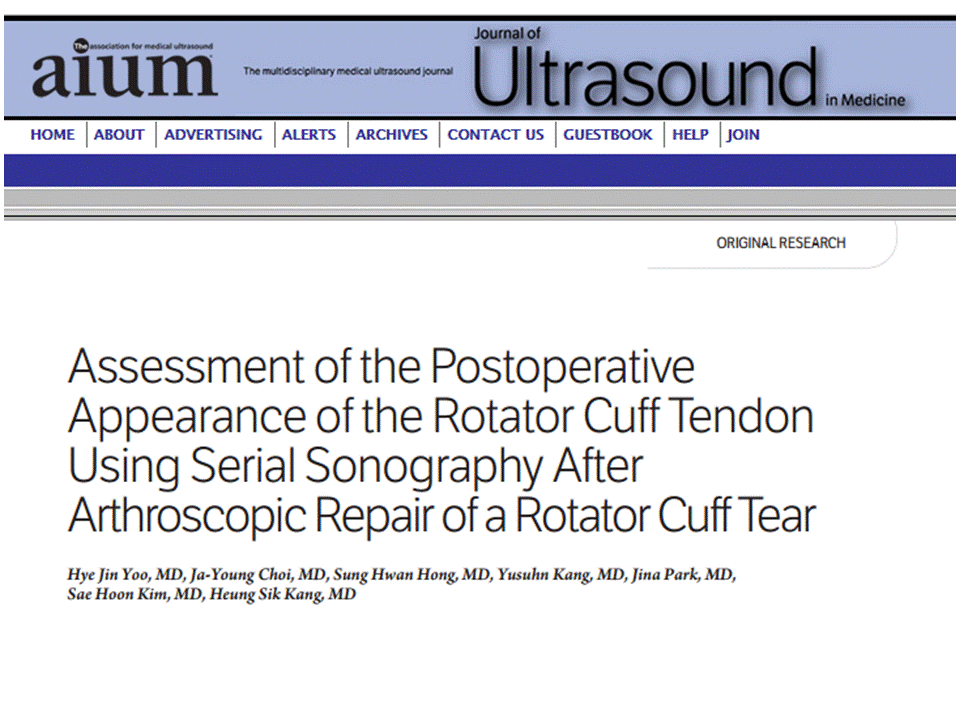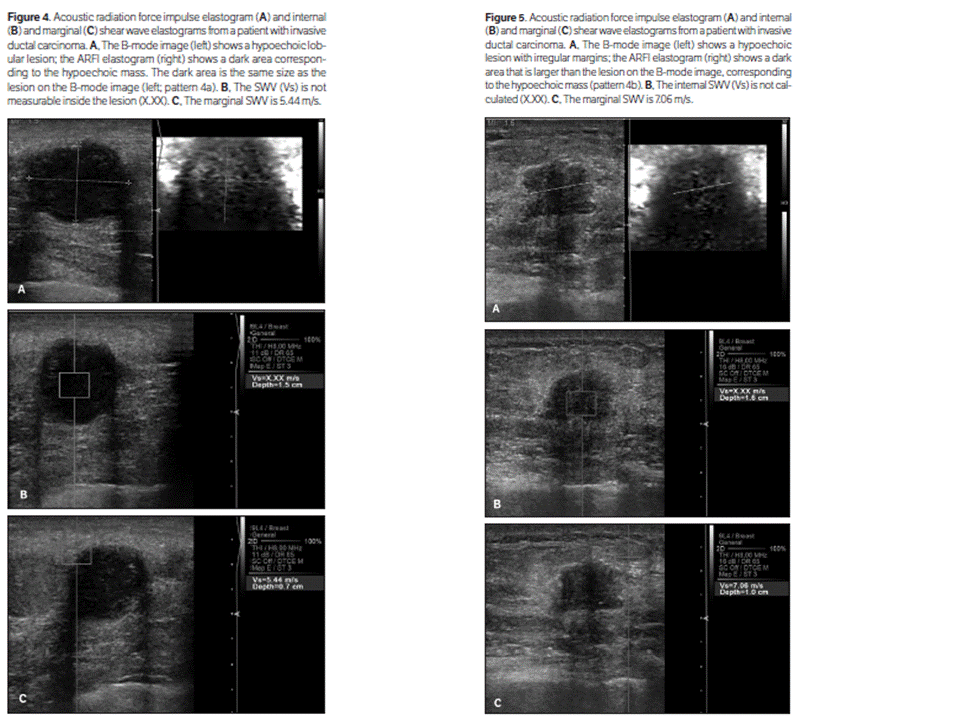Discussion
Although recurrent rotator cuff tears are not uncommon, and
imaging evaluation of a postoperative rotator cuff plays a critical role, as
noted in the introduction, the temporal changes in the postoperative tendon on
sonography have not been well investigated. This study aimed to address the
uncertainties regarding the postoperative rotator cuff on serial follow-up
sonographic examinations. In our study, serial sonographic evaluations of the
repaired rotator cuff revealed mild thinning of the tendon over time. Recurrent
tears of the repaired tendon were not frequent (4 of 65 [6%]), but if they
happened, they always occurred within the first 3 months of surgical repair,
which was concordant with results from a previous study.5 The morphologic appearance
and peritendinous vascularity of the tendon were gradually normalized, although
mild bursal thickening remained 6 months after surgery. Crim et al19 described
the temporal evolution of MRI findings after arthroscopic rotator cuff repair,
with serial MRI examinations at 6 weeks, 3 months, and 12 months after surgery.
The tendons were the most disorganized compared to the native tendons 3 months
after surgery, and they generally improved between 3 and 12 months after
surgery. Fealy et al14 also reported that it was not uncommon to detect a
full-thickness defect on sonography in the early postoperative period; however,
they hypothesized that this defect was a reparative scar rather than a true
retear because it gradually improved over time. Previous histologic studies
supported these results. Four to 6 weeks after surgery, there was disorganized
collagen at the bonetendon interface as well as an irregular zone of edema
between the collagen bundles with neovascularization immediately proximal to
the bone-tendon interface.20,21 The interface tissue became progressively more
organized with time, and the tendon fibroblasts were increasingly oriented
along the tendon.21 Similarly, in this study, there was also a disorganized
appearance, including a decreased echo texture, absence of a fibrillar pattern,
and surface irregularity, in the repaired tendon at 5 weeks and 3 months;
however, this disorganization normalized through remodeling by 6 months after
surgery. Early postoperative tendons frequently had a hypo - echoic echo
texture and the absence of a fibrillar pattern, which might be misinterpreted
as recurrent tears; however, these features often normalized into tendons with
an increased echo texture and the reappearance of a fibrillar pattern at 6
months (Figure 7). Based on these sequential findings, the sonographic findings
within 3 months after surgery should be interpreted with caution to accurately
understand and monitor the repaired tendon status. The defect described by
Fealy et al14 might be similar to the finding mentioned above, although it
could not be confirmed because the authors did not provide an image
illustrating the defect in their article. In terms of the tendon thickness,
Tham et al15 demonstrated that the repaired supraspinatus tendon thickness
remained unchanged throughout 6 months of sonographic analysis, whereas
Lasbleiz et al9 reported an inverse correlation between the tendon thickness
and the time between measurements. In our study, the tendon thickness decreased
over time after surgery, resulting in a 5% to 10% difference in the thickness.
Some patients had marked changes exceeding 30% to 50% of the tendon thickness 5
weeks after surgery (Figure 6). After careful review of the arthroscopic
findings and intense discussion with the surgeon, this change was thought to be
a postoperative deformity, a “dog ear” deformity, at the repaired tendon with
spontaneous remodeling over time.22 Subacromial-subdeltoid bursitis decreased
significantly over time; however, mild bursal thickening was frequently
observed at 6 months. This finding was consistent with a study performed by
Tham et al,15 which demonstrated a significant decrease in the bursal
thickness, capsular thickness, shoulder stiffness, and level of pain over time.
Another interesting issue in the healing of a rotator cuff is the vascularity
of the rotator cuff after surgical repair because blood at the site of a
repaired tendon encourages the reestablishment of the bone-tendon
attachment.13,14 Several studies have shown the vascular pattern in the
repaired tendon on Doppler studies with or without a contrast agent.13–17These
studies reported initial high vascular flow at the peritendinous region that
decreased with time, whereas the repaired tendon showed either sparse or no
blood flow. However, it was uncertain whether the vascularity at the bone
anchor site was increased. The bone anchor site had the lowest blood flow on
conventional Doppler studies,14whereas marked enhancement in the suture anchor
and the peribursal regions were observed on contrast-enhanced
sonography.13,16,17 The authors explained that the discrepancy between the
findings from the contrast-enhanced and conventional Doppler studies could be
attributed to the increased sensitivity of microbubble contrast techniques. In
our study, the peritendinous region had the greatest blood flow, which
decreased on follow-up sonography, and the bone anchor site and tendon remained
relatively avascular. This result was consistent with studies performed using
conventional Doppler analysis without microbubble contrast. On the basis of the
finding of the most robust, highest vascularity in the peribursal tissue, some
authors have suggested that the peribursal tissue might be the greatest conduit
of blood flow for promoting healing of the repaired tendon.13,14,17 However, no
data have shown the relationship between the peribursal vascularity and the
retear rate or clinical outcomes, and further investigation is warranted. Our
study had several limitations. First, subjective criteria were used to assess
the morphologic tendon characteristics. Although efforts were made to use
reproducible criteria, it was difficult to apply consistent and reproducible
criteria between patients and examinations because of the operator-dependent
nature of sonography. Second, it was at times difficult to assess the repaired
tendon in the early postoperative period in patients with severe pain and a
limited range of motion. Third, the follow-up was rather short, and further
investigations of the long-term outcomes or prognoses 1 and 2 years after
surgery are needed. Nevertheless, sonographic assessment of the repaired tendon
3 months after surgical repair might be important because the clinical
examination at this time might be limited by immobility and pain, and most
recurrent tears occur within the first 3 months of surgical repair. Fourth, the
sizes of the rotator cuff tears were not uniform in our study. Fifth, there was
no surgical proof of retears. Finally, clinical findings, including stiffness
and the level of pain, were not assessed in our study. Further study is
warranted to determine whether the sonographic appearance of a healing tendon
correlates with the level of pain. In conclusion, we have demonstrated that the
occurrence of a retear developed within 3 months after surgery, and the tendon
thickness and morphologic appearance of the repaired tendon improved over time
and nearly normalized within 6 months after repair. In our study, the
sonographic findings in the first 3 months after surgical repair should be
interpreted with caution to accurately understand and monitor the repaired
tendon status.













